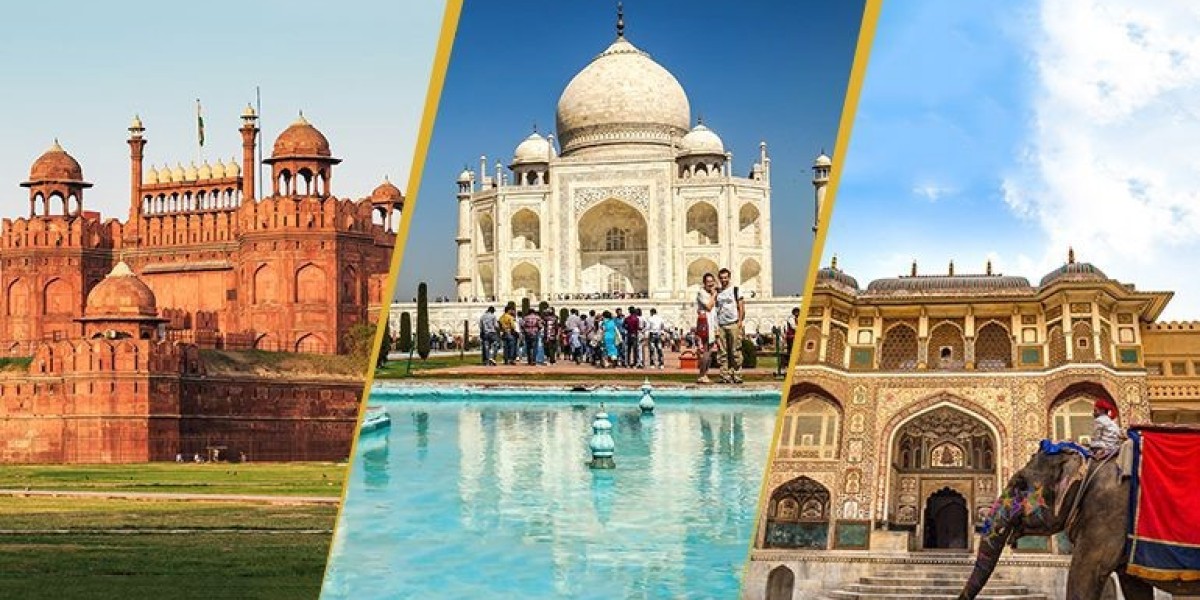India’s Golden Triangle is one of the most popular tourist circuits in the country, offering a perfect blend of historical landmarks, cultural experiences, and architectural marvels. This iconic route connects three of India’s most fascinating cities: Delhi, Agra, and Jaipur. Known for its rich history and heritage, the Golden Triangle India tour offers travelers an unforgettable experience filled with ancient monuments, royal palaces, and vibrant markets. Here are the top attractions in India’s Golden Triangle that you absolutely can’t miss.
1. Delhi – The Capital City
As the first point of the Golden Triangle India, Delhi is a city steeped in history and culture. It is a bustling metropolis where the old meets the new. From ancient forts to modern shopping malls, Delhi offers an array of attractions for every type of traveler.
Red Fort: A UNESCO World Heritage Site, the Red Fort is a massive red sandstone fort that served as the main residence of the Mughal emperors. The architectural grandeur of the fort, combined with its historical significance, makes it a must-visit attraction in Delhi.
Qutub Minar: Another UNESCO-listed site, the Qutub Minar is the tallest brick minaret in the world, standing at 73 meters. Surrounded by ancient ruins, the monument reflects India’s rich Islamic heritage.
India Gate: A war memorial dedicated to soldiers who lost their lives in World War I, India Gate is a prominent landmark in Delhi. Its surrounding gardens make it a perfect spot for an evening stroll.
Humayun’s Tomb: Often considered a precursor to the Taj Mahal, Humayun’s Tomb is a beautiful example of Mughal architecture. Its lush gardens and detailed carvings are a sight to behold.
2. Agra – The City of the Taj Mahal
Agra, the second city on the Golden Triangle India circuit, is synonymous with the Taj Mahal, one of the Seven Wonders of the World. However, Agra has much more to offer than just the Taj Mahal.
Taj Mahal: No visit to Golden Triangle India is complete without seeing the Taj Mahal. This magnificent white marble mausoleum was built by Emperor Shah Jahan in memory of his beloved wife, Mumtaz Mahal. The intricate carvings, beautiful gardens, and the reflection of the monument in the surrounding water pools create a magical experience, especially at sunrise or sunset.
Agra Fort: Just a short distance from the Taj Mahal, the Agra Fort is another UNESCO World Heritage Site. This massive red sandstone fort was once the seat of the Mughal Empire and is home to several stunning palaces, including the Jahangir Palace and the Khas Mahal.
Itimad-ud-Daulah: Often called the “Baby Taj,” Itimad-ud-Daulah’s Tomb is a smaller but equally impressive monument. Its detailed inlay work and beautiful garden setting make it a hidden gem in Agra.
3. Jaipur – The Pink City
The final city in the Golden Triangle India route is Jaipur, known as the Pink City due to its pink-colored buildings. Jaipur is the capital of Rajasthan and is famous for its royal palaces, forts, and vibrant culture.
Amber Fort: Perched on a hilltop, Amber Fort is one of the most iconic attractions in Jaipur. The fort, with its majestic courtyards, stunning architecture, and scenic views, offers a glimpse into the grandeur of Rajasthan’s royal past. Visitors can also enjoy an elephant ride to the top of the fort.
Hawa Mahal: Also known as the Palace of Winds, the Hawa Mahal is a striking pink sandstone building with hundreds of intricately carved windows. It was designed to allow the royal women to observe street life without being seen.
City Palace: Located in the heart of Jaipur, the City Palace is a sprawling complex of courtyards, gardens, and buildings. It is still home to the royal family of Jaipur and houses several museums displaying artifacts from Rajasthan’s rich history.
Jantar Mantar: A UNESCO World Heritage Site, Jantar Mantar is an astronomical observatory built by Maharaja Jai Singh II. It features a collection of massive instruments used to measure time, track celestial bodies, and predict eclipses.
Tips for Traveling the Golden Triangle India
Best Time to Visit: The best time to explore the Golden Triangle India is during the cooler months from October to March. The weather is pleasant, making it ideal for sightseeing.
Travel Mode: The cities in the Golden Triangle are well-connected by road and train. Opting for a private vehicle or guided tour will make the journey more comfortable, allowing you to explore hidden gems along the way.
Accommodation: From luxury hotels to budget stays, the Golden Triangle India offers a wide range of accommodation options. Each city has unique heritage hotels that provide a royal experience, especially in Jaipur.
Conclusion
The Golden Triangle India is a must-see travel route that offers an immersive experience into India’s rich history, culture, and architectural wonders. From the bustling streets of Delhi to the romantic allure of the Taj Mahal in Agra, and the royal splendor of Jaipur, this circuit takes you on an unforgettable journey. By exploring both the popular and hidden attractions, you’ll gain a deeper appreciation of India’s diverse heritage, making your Golden Triangle India trip truly memorable. More Information Here-
https://www.sostraveltoindia.com/india-tours/golden-triangle-india-tours/









